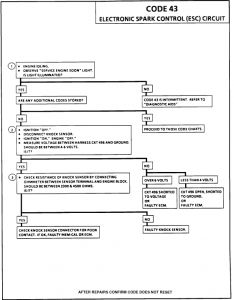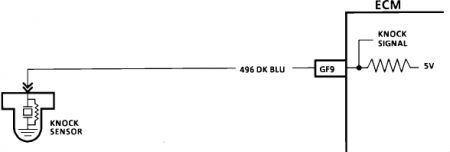

CIRCUIT DESCRIPTION :
The knock sensor detects engine detonation and the ECM retards the electronic spark timing based on the signal being received. Under a no knock condition, the circuitry within the knock sensor causes the ECM 5 volts to be pulled down so that CKT 496 would measure about 2.5 volts. The knock sensor produces an AC signal which rides on the 2.5 volts DC voltage. The amplitude and signal frequency are dependent upon the knock level.
The ECM performs two tests on this circuit to determine if it is operating correctly. If either of the tests fail, a Code 43 will be set.
If there is an indication of knock for 3.67 seconds over a 3.9 second interval with the engine running.
If ECM terminal voltage is either above about 3.75 volts (indicating open CKT 496), or below about 1.25 volts (indicating CKT 496 is shorted to ground) for 5 seconds or more.
TEST DESCRIPTION : Number(s) below refer to circled number(s) on the diagnostic chart.
If the conditions for the test as described above are being met, Code 43 will be currently set and the SES light will be illuminated.
The ECM has a 5 volt pull-up resistor which should be present at the knock sensor terminal.
This step checks that the internal resistance of the knock sensor is within an acceptable range.
DIAGNOSTIC AIDS :
Check CKT 496 for a potential open or short to ground.
Also check for proper installation of MEM-CAL.
Mechanical engine knock can cause a knock sensor signal. Abnormal engine noise must be corrected before using this chart.
https://www.2carpros.com/kpages/auto_repair_manuals_alldata.htm
Thursday, May 20th, 2010 AT 4:52 AM

